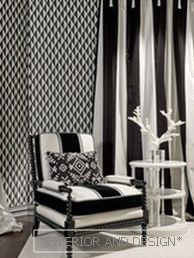 Beautiful well-groomed flower beds and even neat beds can not be imagined without garden curbs. There are many ways to arrange a flower bed or protect fruit and vegetable crops. Curbs for flower beds and flower beds can be made of a variety of materials: metal, plastic, wood, stone, brick or concrete. Manufacturers offer many options for decorative fencing for the garden, but most often gardeners use the materials at hand, showing ingenuity and imagination.
Beautiful well-groomed flower beds and even neat beds can not be imagined without garden curbs. There are many ways to arrange a flower bed or protect fruit and vegetable crops. Curbs for flower beds and flower beds can be made of a variety of materials: metal, plastic, wood, stone, brick or concrete. Manufacturers offer many options for decorative fencing for the garden, but most often gardeners use the materials at hand, showing ingenuity and imagination.
Content
- 1 Garden Curb Functions
- 2 Garden borders made of wood
- 3 Plastic for decoration of beds and flower beds
- 4 Traditional brick
- 5 Natural stone for a border
- 6 Pergons
- 7 Garden curbs made of concrete
- 8 Metal fences
- 9 Beds and flower beds made of scrap materials
Garden Curb Functions
In addition to decorative and aesthetic purposes, fencing for beds and flower beds are important practical benefits:
- give accuracy to beds and flower beds;
- limit the growth of weeds that can not penetrate beyond the borders of the recessed border;
- keep cultivated plants and flowers in a limited area;
- do not allow the soil to crumble when watering, retain its fertile layer;
- reduce the movement of crawling pests;
- provide more rational watering;
- simplify the care of plants: weeding, fertilization, weed removal and other gardening events;
- fenced plants are easier to cover with foil, to install greenhouse arcs, to equip warm and high beds for heat-loving crops.
Garden borders made of wood
Wood is the most popular material for the manufacture of flower beds and beds. Wood is attractive for its environmental friendliness, affordable cost and good maintainability. The minus of wooden products is rapid deterioration, especially in conditions of high humidity and constant contact with the ground. Special antiseptics help briefly prolong the life of the wood.
Wooden curb can make of the following materials:
-
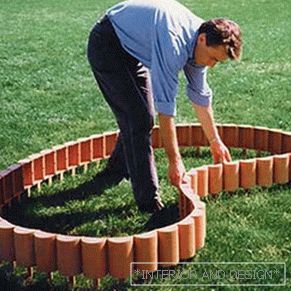 Boards. The easiest and most reliable way to arrange a bed or a flower garden is to put together a strong box. You can make tiered flowerbeds from the planks or create a high bed for fruit and vegetable plants.
Boards. The easiest and most reliable way to arrange a bed or a flower garden is to put together a strong box. You can make tiered flowerbeds from the planks or create a high bed for fruit and vegetable plants. - Scourge. Decorative border from a rod fine option for beds in a rustic style. And completely free, if the manufacture and search for the material to produce independently. Most of the time, for wickerwork, flexible willow branches are used, although these can be any branches of sufficient length and elasticity.
- Border for beds and flowers from chocks. As the original fence for flowers or plants, you can use logs of small diameter. The sawn chocks of the desired length are buried vertically along the perimeter of the flower bed. For greater durability, the lower ends of the logs can be wrapped with roofing felt or dipped in bitumen mastic.
Plastic for decoration of beds and beds
PVC borders are practical, attractive and very realistic imitate natural materials: wood, stone, brick or metal. Of the many useful properties plastic products worth noting:
- affordability;
- not susceptible to moisture, rotting, fungi and insect infestation;
- frost resistance;
- lack of care and maintenance;
- simple assembly and disassembly;
- ease of construction;
- a large variety of plastic products;
- durability.
The most popular are the following types of plastic curbs:
-
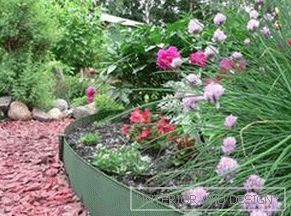 Garden tapes. Flexible PVC border, widely used to mark the boundaries of garden paths, flower beds, lawns. Also, using plastic tape, you can arrange beds of different heights - from 20 to 50 cm. The tape has an average rigidity, keeps its shape well and is easy to install. The garden tape in rolls is realized. The most popular colors are green and brown.
Garden tapes. Flexible PVC border, widely used to mark the boundaries of garden paths, flower beds, lawns. Also, using plastic tape, you can arrange beds of different heights - from 20 to 50 cm. The tape has an average rigidity, keeps its shape well and is easy to install. The garden tape in rolls is realized. The most popular colors are green and brown. - Border "Labyrinth". Low plastic fence under the "stone". The presence of small holes and protrusions allows you to use a lawnmower and mow the grass, even at the edge of the curb. "Labyrinth" perfectly restrains the penetration of weeds and lawn grass into the territory of a flower bed or bed.
- Panels "Garden Board". A very beautiful and easy to install border resembles a wooden plank in appearance. The panels have increased rigidity and strength, they are often used to create sandboxes, multi-tiered flower beds and high beds. The panels have a length of up to 3 m and a height of up to 15 cm. Special fastenings allow the panel to be built up both in length and in height.
- Garden Designer. Flexible decorative fencing, consisting of individual parts. The designer is perfect for creating beds of any shape. Installing the curb is done in seconds - you just need to stick it into the ground.
- Decorative borders from plastic. Presented in a wide variety of colors and shapes - these can be tapes with various ornaments, imitations of a picket fence or forged fences.
Traditional brick
Кирпичная окантовка цветника или садовой дорожки будет смотреться вполне органично, особенно на фоне дома, выполненного из такого же материала. Brick Border можно perform in different ways:
-
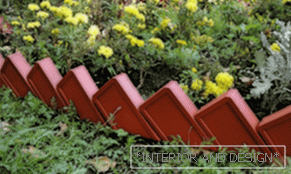 dig straight or at an angle;
dig straight or at an angle; - lay out in one or more rows with the help of cement mortar;
- make a raised bed of any shape;
- to make a barrier with a barrier for lawn grass, placing one row of bricks on the edge, and the second by digging next to the ground flat.
By analogy with a brick for a neat and durable curb, you can use paving stones. Minus fences made of brick - this is a high price and stationarity.
Natural stone for a border
Original flower bed can to make from natural stone. Of course, to make a fencing beautiful and durable, you have to spend a lot of time and effort. The easiest way to make a curb is to lay it out of large stones in one row. More impressive will be flowerbeds, laid out in several levels and fastened with cement.
Stone material is heavy and so that such a border does not settle over time, it is advisable to take care of a reliable concrete base. Stone fences are perfect for creating high beds and retaining walls in areas with difficult terrain.
Pergons
Another option for fencing using natural stone - pergon. They are a mesh steel frame filled with stones. Other materials can also serve as a filling: wood cuts, glass, broken brick.
Pergons are ideal for creating original beds, tall beds, retaining walls. This garden curb is absolutely eco-friendly and will not harm the plants. If you use an inexpensive filler, the cost of fencing from the grid will be cheap enough, and installation will not take much time. Pergon do not need a foundation and can be installed on any surface.
Garden curbs made of concrete
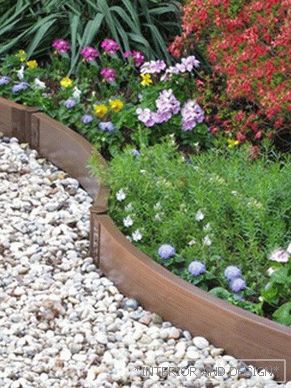 Curbstone made of concrete is very attractive and durable. He is not afraid of high humidity, frost or mechanical pressure. Garden borders made of concrete is a classic element of landscape design, they are used for edging flowerbeds, garden paths, lawns and various sites on the site.
Curbstone made of concrete is very attractive and durable. He is not afraid of high humidity, frost or mechanical pressure. Garden borders made of concrete is a classic element of landscape design, they are used for edging flowerbeds, garden paths, lawns and various sites on the site.
Concrete Curb can be purchased in finished form or make yourself. For this curb blocks are cast in suitable forms. Another way - the manufacture of a monolithic concrete curb. To do this, the cement mortar is poured into the installed formwork of boards or plywood.
The disadvantages of the curb of concrete include heavy weight, which complicates the installation and disassembly. And move the fence, made by the method of monolithic fill, and did not work.
Metal fences
Modern metal curbs for the garden made of galvanized steel. Often, an additional polymer layer is applied to the galvanized surface of the product. Such a border for the beds has a long service life and allows you to permanently resolve the issue with the arrangement of the garden plot. Manufacturers give a guarantee for galvanized products - 15 years, for beds with a polymer layer - 20 years, and with a polyurethane coating - up to 50 years.
There are many advantages to galvanized fencing:
- corrosion resistance;
- resistance to rotting, moisture, mildew and mildew;
- lightness and strength;
- durability;
- simple assembly and installation;
- the ability to complement the bed in length and height;
- esthetic and accurate appearance;
- harmlessness of the material for the soil.
In addition, galvanized beds are the ideal basis for the device. film coated greenhouses. The only disadvantage of galvanized metal fencing is the high price. Although over time such an acquisition will pay off, not everyone has the opportunity to spend a large amount on the design of a bed or flower bed, despite all their positive aspects.
Beds and flower beds made of scrap materials
It is possible to put the beds in order and creatively arrange the flowerbeds from materials that, at first glance, are not intended for this at all - roofing materials, empty bottles, old tires, barrels, buckets and even interior items that have become unnecessary.
-
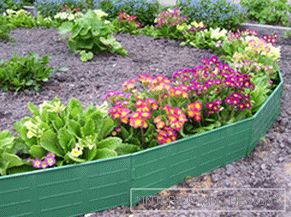 Beds and flower beds of slate. Slate, remaining after replacing the roof, can still do a good service in the form of a practical and durable border for a flower bed or garden bed. Install sheets of slate is not difficult, it must be instilled into the ground around the perimeter of the future beds or flower beds and backed up with reinforcing rods for reliability.
Beds and flower beds of slate. Slate, remaining after replacing the roof, can still do a good service in the form of a practical and durable border for a flower bed or garden bed. Install sheets of slate is not difficult, it must be instilled into the ground around the perimeter of the future beds or flower beds and backed up with reinforcing rods for reliability. - Decking. This roofing material is resistant to corrosion and as a neat and strong garden curb will last a long time. The professional sheet bends well and with its help you can arrange the beds and flower beds of complex configurations.
- Bottle fences. A very interesting, durable and completely free garden bed or flower bed can be made with your own hands from empty plastic or glass bottles. The main thing is to collect a sufficient amount of the same container to make the composition look harmonious. Most often in the manufacture of garden curb, empty container is simply buried in the ground neck down. To make the fence more original bottles lay out with the help of the solution in several rows.
- Car tires. Despite the simplicity, figuratively sliced, decorated or painted rubber tires can become a very effective basis for flowers or herbs.
- Housewares and furniture. Leaky pots, pots, old dressers can get a second life as an unusual flower bed.
Fenced beds and flower beds make the process of working in the garden more pleasant and efficient, and yield is much higher. And, of course, the beauty and well-groomed area cannot but please the eye of its owner.



